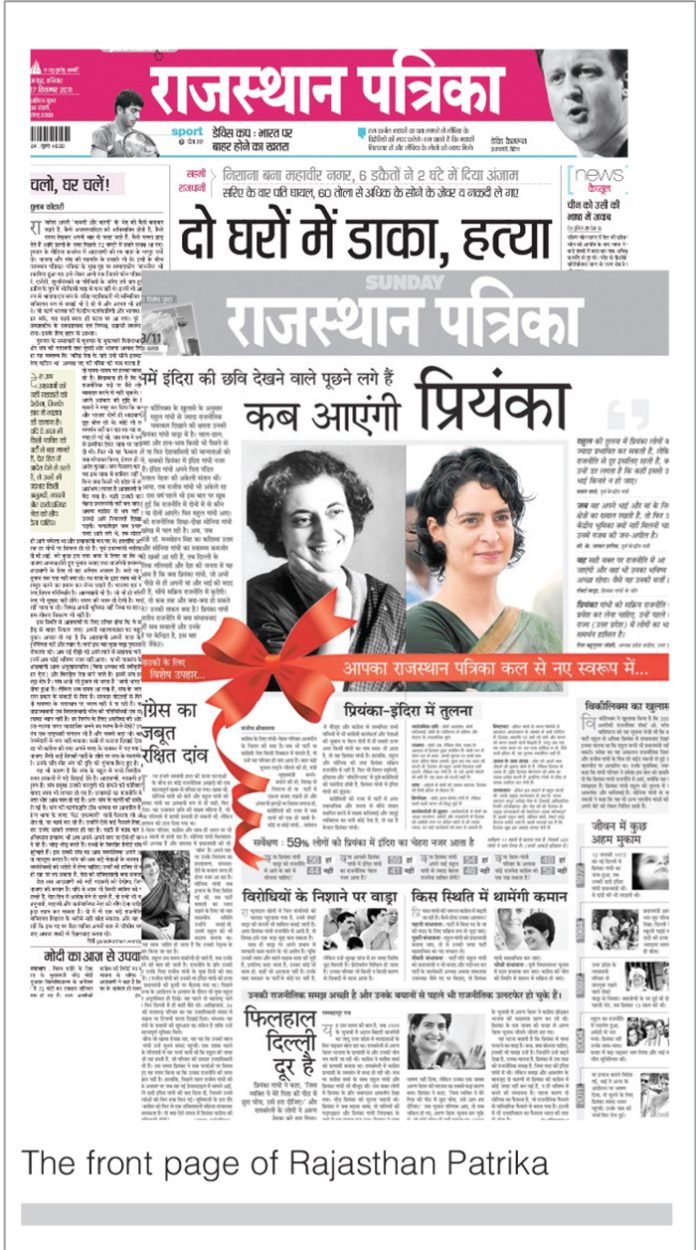Every summer the IPL cricket tournament strikes fear in the minds of India’s media barons as the nation’s attention and the corporate advertisement budget gets mesmerized by a single event. This year it is the Indian elections that rule the roost pushing IPL to the background.
Elections have not only increased TV viewership but also newspaper readership.
Today the newspapers and TV Channels are pulling out all stops to put their best foot forward and make election coverage as widespread and effective as possible. Indian Printer and Publisher spoke to Rajasthan Patrika, a leading Hindi daily with a readership of over 18 million in the eight states in the Hindi heartland of India that brings to the parliament over two-third of the nation’s parliamentarians. “We do not stop with the election coverage” says Dr Shipra Mathur, news editor, Rajasthan Patrika.”We monitor governance round the year. Five years ago we adopted a policy of pre-election, during election and post election coverage and media monitoring under the ‘Jago Janmat’ program to promote public participation and ensure elected representative accountability” she adds. This campaign was widely acclaimed and received the national media award.
In the 2014 election Rajasthan Patrika has extended the initial campaign to 520 constituencies under the Vision 2025 program, covering three states of Madhya Pradesh (230 constituencies), Rajasthan (200 constituencies) and Chattisgarh (90 constituencies). The planning for the program started with a brainstorming meeting by the editorial team in March 2013, a year before the elections in which the objective, structure and format was discussed. Thereafter the resident editors from the Patrika’s 34 print editions and 200 plus hyper local editions took up the challenge and training and motivational camps were held in Jaipur, Bhopal and Raipur to train the 520 journalists who would steer the program.
The political report card
Feedback was received after 5,200
meetings were conducted throughout 2013 by this trained Rajasthan Patrika team interacting with citizen groups comprising of 70 to 100 members in each constituency. “The purpose of the program is to bring to the political parties and contestants 520 different manifestos tailor-made to the needs of the people of each constituency” says Mathur. Vision 2025 was envisaged to help develop each constituency with a long-term vision document that spanned at least 10 years. The document gave a guideline to the elected representatives about what they were working for and an
understanding to the people on how to assess political parties. The idea was to empower the voter and make the public representative more accountable. Once the individual constituency needs were determined the political parties were given time to study the document and the candidates were made to sign a pledge about their electoral promises that were given coverage in the newspaper. The final stage of this vision 2025 program will involve post election media monitoring and assessment of elected representatives. Patrika has already brought out a report card of the elected representatives who participated in the last elections and they were given wide coverage by the newspaper. The elected representatives were assessed on ten parameters that covered the fulfillment of election pledges, the use of representative funds, and development of the area. An award was also given for the “Sadan Ke Sitare” or the best legislator performance inside the assembly house that also became very popular and the Patrika initiatives were praised by the Planning Commission of India.
Campaign against freebies
There were ten categories of people who gave feedback for this massive exercise
and nearly 50,000 citizens were also trained on how to chose their leader. Among the categories were the youth, women, community leaders, professionals, businessmen, senior citizens, bureaucrats, children and adolescents, farmers, the unorganized sector and the political class. They were told how to chose and how not to chose their leaders and how to avoid the trap of appeasement.
Being a poor and largely uneducated country, voters in India are often swayed by incentives in cash or kind. Free rice and free liquor now have grown to free laptops and cash in tiffin boxes in the elections. The poll panel this year has already confiscated `300 crore (`3 billion) in cash, 133,000 liters of alcohol and 30,000 kgs of narcotics from 28 states and 7 union territories as of April
17. Large groups of people are also found voting on the basis of caste lines and some leaders have been openly canvassing to this effect.
Campaigning against criminals
Another critical part of the Patrika campaign was educating voters and political parties to keep criminals out of the electoral process. India’s vast unconnected rural hinterland and sprawling urban slums have had mafia
dons and criminals entering the political mainstream.
It is true that slums are ruled by gangs, and
the mafia control over slum dwellers is inevitable, but political parties
especially those at the national level must muster the courage to free politics from undesirable elements. The Patrika campaign
involves strengthening connections between members of the public and elected representatives through
media monitoring. “It helps build public pressure for accountability and trustworthy service on the part of elected representatives” says Mathur. “Such initiatives for the benefit of the society are part of the Patrika campaign and we have taken up several issues like crime against women, holistic inclusive
development, education and health.”
















